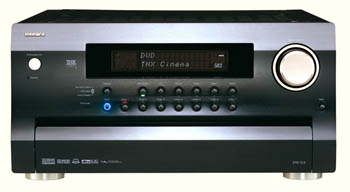|
|
 |
|
Specifications:
● Codecs: DD,
DD-EX, DPL-IIx, DTS, DTS-ES
Discrete/Matrix, DTS Neo:6, DTS 96/24, THX Ultra2-
Certified
● Power Output:
150 Watts x 7 into 8 Ohms, Rated
into 4 Ohms
● DACs: 24/192 on
All Channels
● THD: 0.05%
● Dimensions: 8.8"
H x 17.1" W x 18.9" D
● Weight: 70.8
Pounds
● MSRP: $3,800 USA
Base Price
● Modules: iLink-$200,
Net-Tune-$200, HDMI-$500,
Two Extra Multi-Channel Inputs-$200
Integra
www.integrahometheater.com
|
|
Introduction
OK, hereís the scenario. I get an e-mail asking me if I
want to review the new Integra DTR 10.5 A/V receiver, and naturally my
response was, of course. The next e-mail then tells me to sign on to their
website and configure the review unit the way I want.
Immediately what comes to mind (other
than, "Oh . . . Cool!") is that this is the future of purchasing mid to high-end receivers. And why
not, computers are modular and parts can be added or removed from the chassis
to accommodate upgrades and improvements, so why not order audio components
the way you want them to begin with?
Well that is exactly what Integra has done. The "Built to Order" DTR 10.5
comes with a significant amount of standard features, but the lure here is
customizing it before you buy it. Iíll discuss in detail some of the standard and optional modules
later.
You can try out the Build to Order feature, without actually buying
one, at this URL:
http://www.integrahometheater.com/buildtoorder.cfm.
Integra as you may know is a spin-off of parent company Onkyo, no slouch in
the A/V world either. Considered the high-end series for Onkyo and meant for
the custom installer, the Integra line furthers their reputation with the
flagship DTR 10.5.
The
Design
Touted as the first home theater receiver to be built around a modular-based
architecture, the flagship Integra DTR 10.5 is a THX Ultra2-certified
receiver capable of handling three independent zones. The 10.5 also boasts PC
set-up applications via Ethernet and RS-232.
With a minimum of 150 WPC at 8 ohms with 0.05% THD, or 200 WPC at 6 ohms, the
amplifier produces continuous power output for all channels. It is even rated
into 3 ohms, at 340 watts of dynamic power. So, the days of receivers all
not being able to handle low impedance speakers may be coming to a close (I
suspect it will continue to be an issue with budget receivers though). As you might
expect, this unit is heavy at more than 70 pounds, and almost 9 inches high.

The front of the unit is actually quite conservative, save a concave face and
rather large flip down front panel, activated by a discrete button. Adorning
the face is a small silver on/off standby mode button, a large display screen,
and a strikingly large silver volume control which stands out dramatically
from the black face. Below the display are a series of buttons that activate
potentially fourteen input functions. Two tape, tuner, phono, CD, and DVD,
join seven
video sources and a new Net Audio for Internet Radio, more on that later. The
video inputs are labeled 1 through 7 on the faceplate, yet can be renamed on
the LED display.
Some information is displayed large and readable from a distance; other
information is quite small, perhaps even a bit too small. What is obvious from
a distance is the input source, such as DVD, and listening mode, such as THX or
Direct modes. On the small side, for example, volume level is placed in the
lower right hand corner. Even scrolling up and down it doesnít change size. A
nice feature may have been when the volume is being altered, the unit might have
enlarged the setting to be easily viewed, and return to the diminutive size
once volume level is chosen.
By hitting the Display button, the large screen tells you which type of processing
is occurring, for example Dolby Digital in 3/2.1, and then disappears.
The red-lit indicator for the active surround speakers is barely visible,
likewise for speaker A or B selection. Above the on/off button is a nice
feature: as you operate the remote, the receiver letís you know itís receiving
the transmission through a blinking indicator. With the information on display so
small, itís a consolation to know youíre doing something. Considering the
battery life in the remote, this is also important to know your remote is
communicating with the component.
Behind the flip-down door, youíll find the inputs for video source number 7
mentioned above. It gives you an optical, S-Video, as well as RCA video and
audio left and right. This is for connecting something like a video camera to
play back your vacation videos. A stereo headphone jack adorns the other side.
If youíre prone to making your input selections from the receiver rather than
the remote, here is where you make your choices, such as setup, listening
modes, tone control, zone selection, tuning, and so on.
Click Here to Go to Part II.
Terms and Conditions of Use
|





